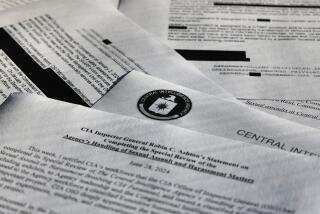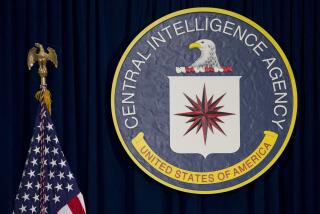CIA drones have broader list of targets
Reporting from Washington -- The CIA received secret permission to attack a wider range of targets, including suspected militants whose names are not known, as part of a dramatic expansion of its campaign of drone strikes in Pakistan’s border region, according to current and former counter-terrorism officials.
The expanded authority, approved two years ago by the Bush administration and continued by President Obama, permits the agency to rely on what officials describe as “pattern of life” analysis, using evidence collected by surveillance cameras on the unmanned aircraft and from other sources about individuals and locations.
The information then is used to target suspected militants, even when their full identities are not known, the officials said. Previously, the CIA was restricted in most cases to killing only individuals whose names were on an approved list.
The new rules have transformed the program from a narrow effort aimed at killing top Al Qaeda and Taliban leaders into a large-scale campaign of airstrikes in which few militants are off-limits, as long as they are deemed to pose a threat to the U.S., the officials said.
Instead of just a few dozen attacks per year, CIA-operated unmanned aircraft now carry out multiple missile strikes each week against safe houses, training camps and other hiding places used by militants in the tribal belt bordering Afghanistan.
As a matter of policy, CIA officials refuse to comment on the covert drone program. Those who are willing to discuss it on condition of anonymity refuse to describe in detail the standards of evidence they use for drone strikes, saying only that strict procedures are in place to ensure that militants are being targeted. But officials say their surveillance yields so much detail that they can watch for the routine arrival of particular vehicles or the characteristics of individual people.
“The enemy has lost not just operational leaders and facilitators -- people whose names we know -- but formations of fighters and other terrorists,” said a senior U.S. counter-terrorism official, speaking on condition of anonymity. “We might not always have their names, but ... these are people whose actions over time have made it obvious that they are a threat.”
In some cases, drones conduct surveillance for days to establish the evidence that justifies firing a missile, the officials said.? Even then, a strike can be delayed or canceled if the chance of civilian casualties is too great, they said.
But some analysts said that permitting the CIA to kill individuals whose names are unknown creates a serious risk of killing innocent people. Civilian deaths caused by Western arms is a source of deep anger in both Pakistan and Afghanistan.
“There are a lot of ethical questions here about whether we know who the targets are,” said Loch Johnson, an intelligence scholar at the University of Georgia and a former congressional aide. “The danger is that it could spawn new terrorists and increase resentment among the Pakistani public, in particular where these strikes are taking place.”
U.S. officials say the strikes have caused fewer than 30 civilian casualties since the drone program was expanded in Pakistan, a claim that is impossible to verify since the remote and lawless tribal belt is usually off-limits to Western reporters. Some estimates of civilian casualties by outside analysts are in the hundreds.
Of more than 500 people who U.S. officials say have been killed since the pace of strikes intensified, the vast majority have been individuals whose names were unknown, or about whom the agency had only fragmentary information. In some cases, the CIA discovered only after an attack that the casualties included a suspected terrorist whom it had been seeking.?
The CIA was directed by the Bush administration to begin using armed drones to track Osama bin Laden and other senior Al Qaeda figures, as well as Taliban leaders who fled to Pakistan’s tribal areas after the Sept. 11 attacks.
President Bush secretly decided in his last year in office to expand the program. Obama has continued and even streamlined the process, so that CIA Director Leon E. Panetta can sign off on many attacks without notifying the White House beforehand, an official said.
Missile attacks have risen steeply since Obama took office. There were an estimated 53 drone strikes in 2009, up from just over 30 in Bush’s last year, according to a website run by the New America Foundation that tracks press reports of attacks in Pakistan. Through early this month, there had been 34 more strikes this year, an average of one every 3 1/2 days, according to the site’s figures.
The 2010 attacks have killed from 143 to 247 people, according to estimates collected by the site, but only seven militants have been publicly identified. Among them are Al Qaeda explosives expert Ghazwan Yemeni, Taliban commander Mohammad Qari Zafar, Egyptian Canadian Al Qaeda leader Sheikh Mansoor, and Jordanian Taliban commander Mahmud Mahdi Zeidan.
Pakistani Taliban leader Hakimullah Mahsud, the architect of a series of suicide bombings and raids on markets, mosques and security installations in the latter half of 2009, was targeted in multiple strikes last year after evidence emerged that he was involved in attacks against the Pakistani government and Americans.
He was initially believed to have been killed in a January drone strike, but apparently survived. This week he appeared in a video, vowing additional attacks against the U.S.
U.S. officials said Wednesday that there is increasing evidence that Mahsud’s group, known as Tehrik-e-Taliban, had helped train the Pakistani American who allegedly attempted to carry out a car bombing in New York’s Times Square.
The attempt may have been a response to the escalating U.S. drone campaign, one official said.
The number of Predator and Reaper drones in the region is classified, but one former official estimated that the size of the fleet has at least doubled in the last year. The increased numbers improve the CIA’s ability to conduct continual surveillance against multiple targets in North Waziristan and other militant strongholds, the officials said.
The CIA maintains a list of senior members of Al Qaeda, the Taliban and other militants, identified by name, whom the agency still tracks and seeks to kill. The decision to widen the program was made because counter-terrorism officials saw militant threats growing, but were unable to use lethal force unless they were able to track a targeted individual.
“In the last year of the Bush administration, the intelligence people had overwhelming evidence that Al Qaeda was regrouping in the tribal areas, and was plotting actively against this country,” said the counter-terrorism official.
“You can’t hear an alarm like that and then do nothing,” the official said, adding that the actions taken by the Bush administration have “intensified since.”
The CIA program is operated independently of the U.S. military, which flies its own unmanned aircraft primarily over Afghanistan and follows different targeting procedures.
The border region is a stew of interlocking and shadowy militant groups, some of which seek to attack U.S. troops in Afghanistan or mount larger attacks against U.S. interests, while others are more focused on overthrowing the Pakistani government.
Some outside analysts caution that it could be difficult to determine whether a suspect about whom little is known represents a threat to U.S. interests.
But former officials who were involved in the program said that many of the groups were found to be working together, and thus were considered legitimate targets. One former official directly involved in the program said many locations were watched so closely that the CIA could predict daily routines.
“Is the white van there yet?” the official said, giving an example of the degree of scrutiny. “Is he walking with a limp?”
Officials say some decisions are straightforward -- for example, if drones observe bomb-making or fighters training for possible operations in Afghanistan. In one case cited by officials, a missile was fired at a compound where unknown individuals were seen assembling a car bomb.
People who are determined to be raising money for Al Qaeda or who only facilitate its operations are not targeted, according to a senior administration official. Such support “is not enough as a matter of administration practice and policy to make you a target for lethal operations,” the official said.
In addition to more drones, U.S. intelligence agencies involved in the program have increased the number of analysts working on tracking targets and have made other technical upgrades that have improved their ability to track and kill militants.
The Pakistani government occasionally complains publicly about the U.S drone strikes, but also has helped expand the program by providing information about possible targets and by clearing airspace, so the drones can operate without risk of collision with other planes, officials said.
More to Read
Sign up for Essential California
The most important California stories and recommendations in your inbox every morning.
You may occasionally receive promotional content from the Los Angeles Times.











